Over time, even the best washing machines turn into a hidden mess of grime, detergent buildup, and mold. You may not see it, but your nose and clothes can tell. If your laundry comes out smelling funky or looking dingy, it’s not your detergent’s fault; it’s your washer waving the white flag.
This complete guide walks you through exactly how to deep clean your washing machine, without hiring a pro or spending your weekend scrubbing like you’re in a detergent commercial. And along the way, we’ll drop bonus insights from other must-read cleaning tips like how to clean a P-trap or prevent kitchen sink clogs, because every part of your plumbing deserves some TLC.
Why You Need to Deep Clean Your Washing Machine

Even if your washer looks clean, there’s a world of hidden sludge inside. Soap scum, bacteria, and mineral deposits can all build up in your drum, seals, filter, and detergent drawer. That buildup doesn’t just look gross—it:
-
Causes musty smells
-
Slows down your machine’s performance
-
Can even transfer stains onto your freshly washed clothes (rude!)
Whether you’ve got a front-load or top-load machine, monthly deep cleaning keeps things fresh and your washer running like new.
Step 1: Wipe Down the Outside and Gasket
Start simple. Unplug the machine for safety.
Mix equal parts white vinegar and water in a spray bottle. Use a microfiber cloth to wipe down the exterior, buttons, and especially the door handle. If you’re dealing with other plumbing areas like your kitchen sink, remember, routine surface cleaning is your first line of defense against buildup.
If you have a front-loader, pay extra attention to the rubber gasket around the door. That seal traps moisture and grime, becoming a playground for mold and mildew.
Pro Tip: Always pull back the rubber seal and check the hidden folds. That’s where the real drama lives.
Step 2: Clean the Detergent Drawer
Pull out the detergent drawer completely. Soak it in warm, soapy water and use an old toothbrush to scrub away soap scum, detergent buildup, and fabric softener residue.
If this part is neglected, it can become just as nasty as a clogged sink drain. Just like you’d clean out your P-trap to stop smells and blockages, your detergent drawer needs love, too.
Step 3: Scrub the Filter (If Accessible)
Front-load washers and some high-efficiency top-loaders have a filter, usually at the bottom front corner. Twist off the cover and gently pull the filter out.
Rinse it under warm water and scrub off any lint, hair, and detergent sludge. You might be shocked by what you find.
Note: Regular filter cleaning helps prevent water from backing up into your machine, similar to managing sewage backup in the basement.
Step 4: Run a Hot Cycle With Vinegar and Baking Soda
Now it’s time to detox the inside.
-
Pour 2 cups of white vinegar directly into the washer drum.
-
Add 1/4 cup of baking soda.
-
Set the machine to the hottest and longest cycle. Let it run empty.
This combo acts like a power couple: vinegar dissolves grime and kills bacteria; baking soda deodorizes and gently scrubs the drum walls.
If your home has low water pressure, consider running a longer rinse to ensure everything flushes out fully.
Step 5: Scrub Inside the Drum and Seal
Once that cycle finishes, open the washer and grab your vinegar-soaked cloth again.
Wipe down the interior, especially the drum walls, corners, and the gasket (yep, again). If you skipped this, you might be surprised at how much gunk still hides behind.
Step 6: Final Rinse and Dry
Run one more hot water cycle, no vinegar or detergent this time. This rinses out any lingering residue or particles.
Then, leave the washer door open for several hours, or overnight if possible. Let the inside dry out completely to prevent mildew.
Pro Tip: This is basically the same philosophy behind how to refresh your home with greenery, airflow, cleanliness, and consistency, to keep your home feeling fresh and healthy.
Bonus Tips to Keep It Fresh
Here’s how to keep your machine feeling fresh between deep cleans:
-
Leave the door open after every wash
-
Use only the recommended amount of detergent (more isn’t better!)
-
Switch to high-efficiency (HE) detergent if you haven’t already
-
Clean monthly, especially if you do frequent laundry loads
-
Watch for early signs of low water pressure or backup issues that might stem from the washer connection
Just like how a spa-like bathroom on a budget needs regular upkeep to stay stress-free and soothing, your washer needs small habits that add up over time.
How Deep Cleaning Impacts Your Plumbing System

Here’s the kicker: your washer isn’t just a standalone appliance. It connects directly into your home’s plumbing system, which means that buildup inside the washer can affect your drains.
A gunked-up washer filter or a blocked outlet hose might create issues similar to a partially clogged P-trap or sink drain, sluggish draining, bad smells, or even a sewage backup in the basement. Deep cleaning prevents this by keeping things flowing properly.
And while you’re at it, check nearby hoses and wall valves for signs of leaks or mold. If your utility room ever starts smelling musty, you could be dealing with a hidden water leak.
Signs Your Washer Needs a Deep Clean

Here are some red flags that it’s time for a deep clean:
-
Your laundry smells musty or damp, even right after a wash
-
You notice black or brown spots around the rubber seal
-
The washer takes longer than usual to complete a cycle
-
Water sits in the drum after a load
-
You notice low flow or delayed drainage (yup, we’re back to low water pressure issues again)
When to Call a Plumber Instead
Sometimes, even after a full deep clean, your washer (or the plumbing connected to it) might still act up. That’s when it’s time to bring in a pro.
Call a plumber if you notice:
-
Water backs up into sinks or drains when the washer runs
-
Leaks coming from hoses or the back of the washer
-
Persistent mold or mildew smell even after deep cleaning
-
Low water pressure that affects multiple fixtures in your home
-
Any signs of hidden water leaks behind or beneath the washer
These could be signs of deeper plumbing issues, like a clogged drain line, a damaged hose, or something bigger in your system. A certified plumber can inspect your connections, clean your lines, and fix the root problem before it turns into a sewage backup in the basement (yikes).
Not sure who to call?
Check out our guide on how to find hidden water leaks or explore our other home maintenance tips to know when a plumber’s help is a must.
FAQ – Deep Clean Washing Machine
Q1: What does “deep clean washing machine” mean?
It refers to thoroughly cleaning both the interior and exterior parts of your washer, like the drum, gasket, filter, and detergent drawer, to eliminate gunk, odors, bacteria, and buildup.
Q2: How often should I deep clean my washing machine?
Every month is ideal, especially if your machine gets heavy use or starts smelling off.
Q3: Can I use vinegar and baking soda to clean a washing machine?
Yes. Vinegar dissolves mineral deposits and bacteria, while baking soda neutralizes odors and lightly scrubs surfaces. They’re like the greenery of the cleaning world, natural, refreshing, and effective.
Q4: What if my washer still smells after deep cleaning?
Check the drain hose for clogs, the wall valve for mold, and consider flushing the water lines. Sometimes, it’s not the washer, it’s your home’s plumbing. Refer to our guide on how to find hidden water leaks to troubleshoot further.
Keep Your Washer and Plumbing Happy
Your washer works hard, don’t make it do it all while swimming in soap scum. Deep cleaning your machine doesn’t just improve its lifespan; it protects your clothes, your nose, and your entire plumbing system from preventable issues.
Whether you’re learning how to prevent kitchen sink clogs, cleaning a P-trap, or turning your bathroom into a budget spa retreat, it all comes down to the same truth: maintenance saves money, time, and headaches.
So roll up those sleeves once a month and give your washer the love it deserves. It’s only 30 minutes of work, but your laundry (and your plumbing) will thank you.






